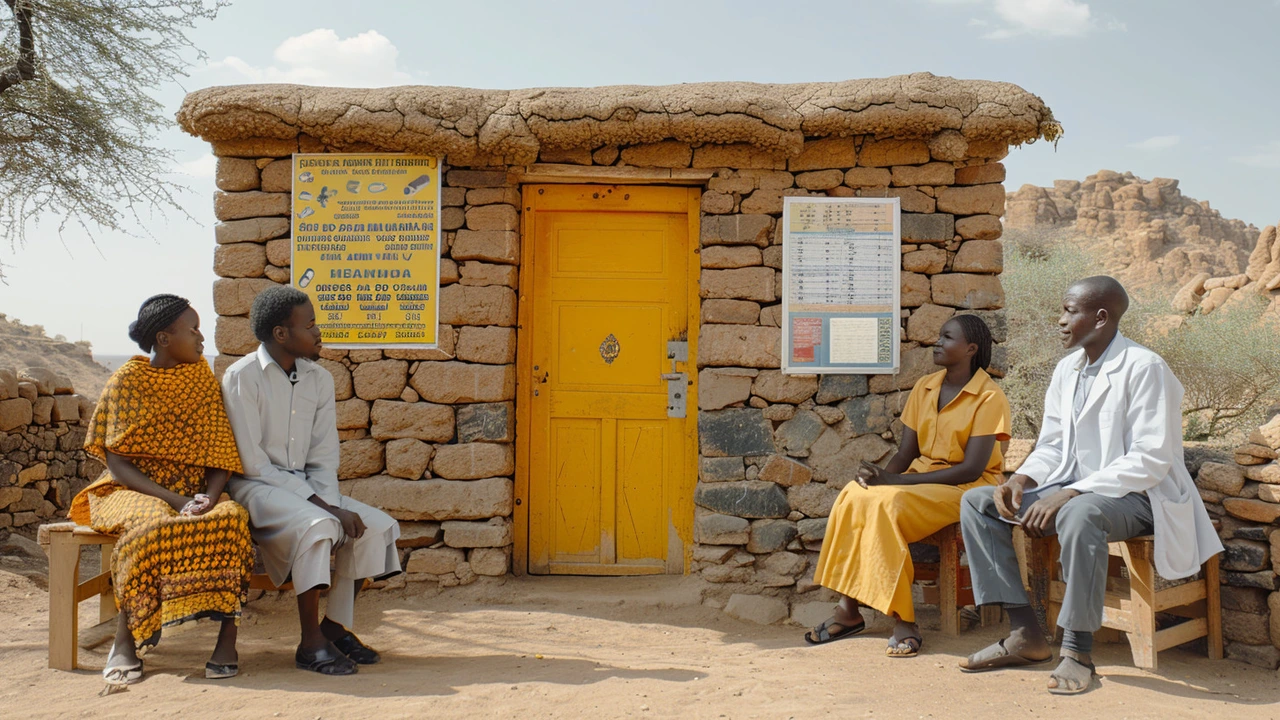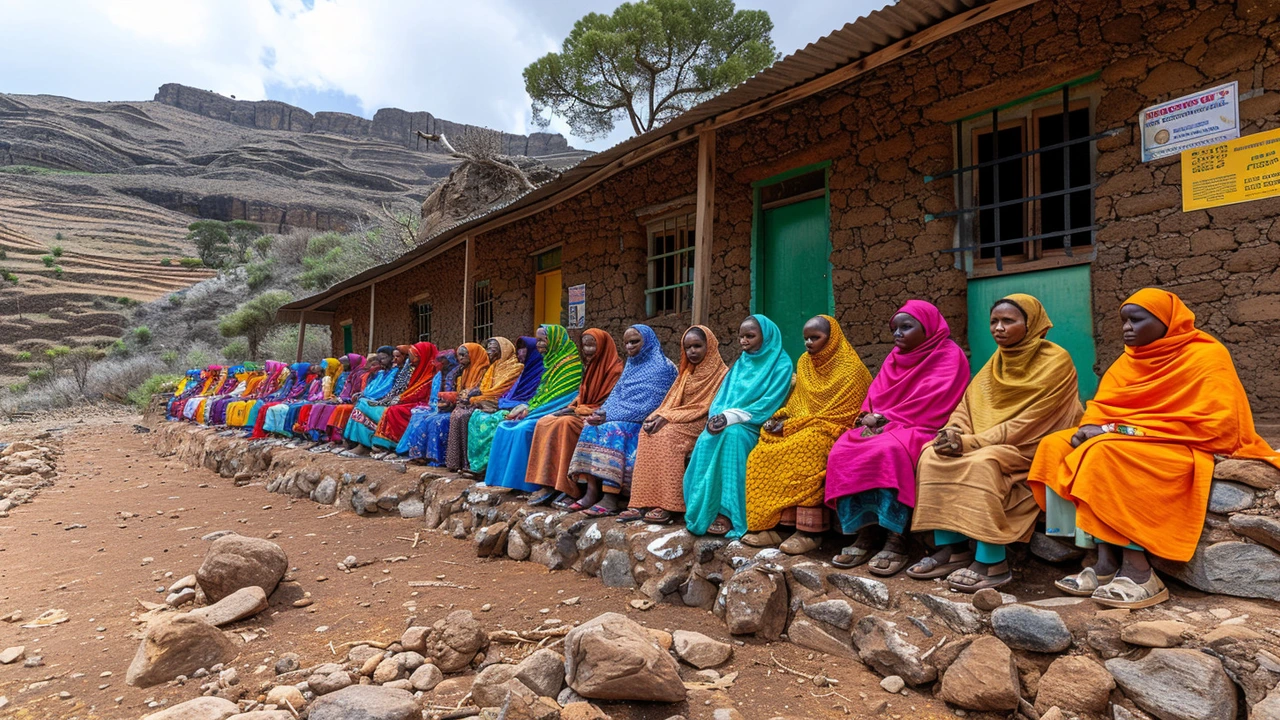Ethiopia is a country with a diversified and developing healthcare system, which raises a common question: Is healthcare free in Ethiopia? This article aims to shed light on this topic, providing readers with a clear understanding of the country's healthcare dynamics.
Both public and private sectors contribute to Ethiopia's healthcare services. While public healthcare aims to be accessible and affordable, the reality includes various costs that patients might encounter. Private healthcare, on the other hand, offers more specialized services but typically at higher expenses.
The costs associated with healthcare in Ethiopia can vary widely depending on the type of care and the institution visited. Public hospitals and clinics may charge nominal fees for services and medications, while private facilities and treatments can be significantly more expensive.
Accessibility and availability of healthcare services in Ethiopia can be challenging, especially in rural areas. Efforts from the government and international organizations strive to bridge these gaps, improving infrastructure and training healthcare personnel to ensure better access to medical care.
This article will explore these topics in detail, providing practical insights and tips for navigating the Ethiopian healthcare system, whether you are a resident, an expat, or simply interested in learning more about healthcare in this part of the world.
- Introduction to Ethiopia's Healthcare System
- Public vs. Private Healthcare Services
- Costs Involved in Receiving Healthcare
- Accessibility and Availability of Medical Services
- Efforts to Improve Healthcare in Ethiopia
Introduction to Ethiopia's Healthcare System
The healthcare system in Ethiopia is a fascinating blend of public and private sectors, striving to cater to a population of over 110 million people. The Ministry of Health oversees the public healthcare system, aiming to provide primary care, preventive services, and essential medications. Despite these efforts, access to quality healthcare remains a significant challenge, particularly in rural regions where infrastructure is lacking.
Historically, Ethiopia's healthcare system has faced numerous hurdles, including limited funding, shortages of trained health professionals, and logistical challenges. According to the World Health Organization, Ethiopia spends only about $20 per capita on health, which is considerably lower compared to the global average. This financial constraint significantly affects the availability and quality of medical services.
An interesting aspect of Ethiopia's healthcare is the Health Extension Program, introduced in 2004. This initiative aims to bridge the gap between rural and urban areas by training health extension workers who deliver basic healthcare services in remote communities. These workers provide vital services such as immunizations, maternal and child health care, and health education, making healthcare more accessible to those who need it most.
The public healthcare system is supported by a network of health centers and hospitals, categorized as primary, secondary, and tertiary facilities. Primary healthcare units, often located in rural settings, offer basic healthcare services and are typically the first point of contact for patients. Secondary and tertiary facilities, usually found in urban areas, provide more specialized and advanced medical treatments.
Influence from international organizations and non-governmental organizations (NGOs) plays a crucial role in boosting Ethiopia's healthcare capabilities. Entities like the Global Fund, UNICEF, and the Bill & Melinda Gates Foundation have been instrumental in combating diseases such as HIV/AIDS, malaria, and tuberculosis through funding and technical support. These collaborations have contributed to significant improvements in health indicators over the years.
The World Bank notes, "Ethiopia has made remarkable strides in maternal and child health, with under-five mortality rates dropping from 123 per 1,000 live births in 2005 to 55 in 2019."
Despite these advancements, the healthcare system still faces many challenges. Shortages of medical supplies, outdated equipment, and long waiting times are common issues in public healthcare facilities. Additionally, a limited number of healthcare professionals struggle to meet the demands of a growing population, often resulting in overworked staff and suboptimal patient care.
On the other side, the private healthcare sector offers higher-quality services but comes at a higher cost, making it inaccessible for the majority of Ethiopians. Private hospitals and clinics mainly operate in urban areas and cater to those who can afford to pay for faster and more specialized healthcare services.
Understanding Ethiopia's healthcare system requires acknowledging the continuous efforts and partnerships dedicated to overcoming these obstacles. While significant progress has been made, the journey towards providing equitable and high-quality healthcare for all Ethiopians is ongoing. The country's experience underscores the importance of sustained investment and innovative solutions in the quest for better health outcomes.
Public vs. Private Healthcare Services
In Ethiopia, healthcare services are provided by both public and private sectors, each having its own set of characteristics and challenges. The public healthcare system is primarily managed by the government and aims to be accessible to a broad section of the population, particularly targeting low-income groups. Public healthcare facilities include hospitals, clinics, and health posts scattered across urban and rural areas. The Ethiopian government has made significant strides in expanding healthcare infrastructure. However, despite these efforts, public healthcare often faces issues such as limited funding, inadequate staffing, and shortages of medical supplies.
Public healthcare services in Ethiopia are subsidized, meaning that while they are not entirely free, the costs are significantly lower than those in the private sector. Patients might pay nominal fees for consultation, treatment, and medications, although these fees can still be a barrier for the poorest families. Despite the lower costs, public healthcare facilities often experience high patient volumes, leading to longer wait times and overcrowded conditions. The quality of care can vary widely, with urban areas generally offering better services compared to rural regions where resources are more limited.
Conversely, the private healthcare sector in Ethiopia provides an alternative for those who can afford more extensive and specialized medical care. Private hospitals and clinics often boast better facilities, shorter wait times, and more personalized services. They are typically more well-equipped with advanced medical technologies and can attract highly trained healthcare professionals. However, the costs involved can be prohibitive for many Ethiopians. For instance, a visit to a private clinic can be several times more expensive than a visit to a public hospital. This cost discrepancy often makes private healthcare accessible primarily to the wealthier segments of the population or those with comprehensive health insurance plans.
The disparity between public and private healthcare services in Ethiopia highlights a broader issue of inequity within the healthcare system. Those who rely on public healthcare are often subjected to the brunt of systemic inefficiencies and resource constraints. Meanwhile, individuals who can afford private healthcare enjoy expedited access to higher-quality services. This gap has prompted calls for more robust policies and investments to balance the scales and ensure that equitable, high-quality healthcare is accessible to all Ethiopians regardless of socioeconomic status.
A report by the Ethiopian Ministry of Health estimated that in urban areas, around 60% of healthcare services are provided by the private sector, whereas in rural areas, public healthcare is the predominant provider. This urban-rural divide exacerbates existing inequities, as rural populations may have to travel long distances to access adequately equipped healthcare facilities. Such disparities are not just inconvenient but can also have severe implications for timely medical intervention and overall public health outcomes.
The difference in service quality and access between the public and private sectors is also a reflection of broader socio-economic challenges facing Ethiopia. Addressing these issues requires comprehensive reforms, targeted investments, and international collaborations. Many global health organizations are working with the Ethiopian government to improve healthcare delivery, focusing on building capacity, training healthcare workers, and ensuring a consistent supply of medical essentials.
“Improving healthcare in Ethiopia is not just about building more hospitals; it’s about creating a sustainable system that serves every citizen equally,” emphasizes Dr. Tedros Adhanom Ghebreyesus, an Ethiopian biologist and Director-General of the World Health Organization.
The duality of Ethiopia's healthcare system—with its public and private facets—presents both challenges and opportunities. While the private sector offers a benchmark for quality and efficiency, the public sector remains crucial for providing affordable healthcare to the masses. Bridging the gap between these two sectors is essential for creating a more balanced and equitable healthcare landscape in Ethiopia.

Costs Involved in Receiving Healthcare
Understanding the costs associated with healthcare in Ethiopia is crucial for both residents and visitors. While Ethiopia's public healthcare system is designed to be affordable, there are still expenses that patients need to consider. The structure of healthcare costs can be complex and varies significantly between public and private sectors.
In public hospitals and clinics, basic medical consultations are often provided at a minimal charge. These fees are set by the government to ensure that healthcare remains accessible to the majority of the population. However, despite the low cost, other expenses can add up. For instance, diagnostic tests, such as blood tests or X-rays, might incur additional costs. Medication fees, although subsidized, are another aspect to consider, as not all medications are covered under the subsidy.
Private healthcare facilities in Ethiopia generally offer higher quality services and shorter waiting times, but these come at a much higher price. A routine doctor’s appointment at a private clinic might cost several times more than a visit to a public hospital. Specialized treatments or surgeries in private hospitals tend to be significantly more expensive, sometimes reaching amounts that are unaffordable for an average Ethiopian household.
One of the challenges facing the Ethiopian healthcare system is the discrepancy in costs and quality of care between urban and rural areas. In cities like Addis Ababa, there are numerous healthcare facilities, both public and private, offering a range of services at various price points. However, in rural areas, access to healthcare is limited, often requiring patients to travel long distances to receive medical attention. This additional travel can result in extra costs for transportation, accommodation, and sometimes even higher service fees due to scarcity of facilities.
It’s noteworthy that international aid and non-governmental organizations (NGOs) play a significant role in subsidizing healthcare costs in Ethiopia. Programs funded by organizations such as the World Health Organization (WHO) and the United Nations International Children's Emergency Fund (UNICEF) often cover costs for vaccinations, maternal health services, and treatment for HIV/AIDS, malaria, and tuberculosis. These efforts are crucial in reducing the financial burden on patients and improving public health outcomes.
According to a report by the WHO, "Ethiopia has made significant strides in reducing child mortality and improving maternal health through subsidized healthcare programs." Such initiatives not only alleviate financial pressures but also contribute to the overall well-being of the population.
Another important factor to consider is health insurance. While health insurance coverage is not widespread in Ethiopia, there are government schemes aimed at expanding coverage, particularly for those in low-income brackets. The Community-Based Health Insurance (CBHI) initiative helps many families afford healthcare services by pooling risk and resources. As this program grows, it is likely to further influence the cost of receiving healthcare in Ethiopia.
For expats or tourists, acquiring private health insurance before traveling to Ethiopia is strongly recommended. This insurance typically covers most medical costs, including emergency evacuations if necessary. Given the variable quality and cost of healthcare services, having insurance provides peace of mind and financial protection.
Accessibility and Availability of Medical Services
Ethiopia's healthcare system faces significant challenges when it comes to the accessibility and availability of medical services. This is especially true in rural areas, which comprise a substantial portion of the country. Often, the nearest healthcare facility is hours away, requiring patients to travel long distances on foot or through difficult terrains. When they arrive, they may find that the facility lacks essential resources or qualified personnel.
In urban centers, healthcare services are more readily available, but there are still hurdles. Government hospitals in cities like Addis Ababa can be overcrowded, resulting in long wait times and limited availability of advanced medical treatments. This exacerbates the strain on the healthcare system, leaving patients frustrated and sometimes with their conditions worsening due to delays.
According to Dr. Tedros Adhanom Ghebreyesus, the Director-General of the World Health Organization, 'Increasing the capacity and coverage of healthcare in rural areas is fundamental to achieving universal health coverage in Ethiopia.'
Various factors contribute to the inaccessibility of medical services in Ethiopia. A critical issue is the shortage of healthcare professionals. Ethiopia has one of the lowest ratios of doctors to patients globally, which leads to longer waiting times and reduced quality of care. The country has been working on training more doctors and nurses, but progress is slow and often hindered by financial constraints and brain drain, where trained professionals seek opportunities abroad.
Another essential aspect is the availability of medications and medical equipment. Many healthcare facilities, especially in rural regions, face chronic shortages of drugs and basic medical supplies. This shortage forces patients to travel further or even go without necessary treatments. The government and various non-governmental organizations are continuously working to improve the supply chain, ensuring that essential medications reach even the most remote areas.
Infrastructure is also a significant barrier. Poor road conditions and lack of transportation options make it difficult for patients, especially from low-income backgrounds, to access healthcare. During the rainy season, certain areas may become entirely cut off from medical services, causing increases in untreated illnesses and mortality rates. Improving infrastructure is a vital step towards better accessibility, and there have been efforts to build more roads and improve transportation systems nationwide.
On a positive note, there are ongoing initiatives to bridge these gaps. Programs like the Health Extension Program (HEP) have been instrumental in providing basic healthcare services to rural communities. Health Extension Workers are trained community members who deliver preventive and basic curative services at the grassroots level. This initiative aims to make healthcare more accessible and reduce the burden on larger healthcare facilities.
Additionally, mobile health clinics have been introduced in some regions to reach populations with limited access to medical services. These mobile units travel to remote areas, offering essential healthcare such as vaccinations, maternal and child health services, and treatment for common illnesses. Mobile clinics have significantly impacted improving health outcomes in underserved areas.
Technology also offers potential solutions. Telemedicine is being explored as a way to provide consultations and medical advice remotely, making healthcare more accessible to those living in hard-to-reach areas. While still in the early stages of implementation, the success of telemedicine could revolutionize how healthcare is delivered across Ethiopia.
The government's commitment to improving healthcare accessibility is clear, but the road ahead is long. Comprehensive policies and sustained international support are key to overcoming these challenges. While the current situation is filled with hurdles, ongoing efforts and innovations hold promise for a future where healthcare is more accessible to every Ethiopian, regardless of location or socio-economic status.

Efforts to Improve Healthcare in Ethiopia
In recent years, Ethiopia has embarked on a journey to enhance its healthcare system through various initiatives and programs. The Ethiopian government, along with international organizations, is taking significant steps to ensure better access to medical services across the nation. One of the central objectives is to make healthcare more accessible and effective for both urban and rural populations.
A major element of this transformation is the Health Extension Program (HEP), launched by the Ministry of Health. This program aims to bring healthcare services closer to the communities, especially in rural areas. It trains health extension workers who provide essential healthcare services directly to the households. By focusing on preventive care, maternal and child health, and control of common infectious diseases, the HEP is helping to reduce the burden of disease and improve overall health outcomes.
Dr. Lia Tadesse, Ethiopia's Minister of Health, has stated, "The Health Extension Program is pivotal in closing the gap between healthcare providers and the community. Its success story is a testament to the power of community-based health approaches."
In addition to the HEP, Ethiopia is also investing in the construction and renovation of healthcare facilities. Many new hospitals, clinics, and health posts are being built with the aim of improving infrastructure. This initiative includes equipping these facilities with modern medical equipment and ensuring a steady supply of necessary medications.
Another significant effort is the expansion of medical education and training. Ethiopia has seen a rise in the number of medical schools and training centers for health professionals. By increasing the number of qualified doctors, nurses, and allied healthcare workers, the country hopes to enhance the quality of care provided to its citizens.
International Partnerships and Aid
International organizations and foreign governments are also playing a crucial role in supporting Ethiopia's healthcare improvements. Agencies like the World Health Organization (WHO), the United States Agency for International Development (USAID), and the Global Fund have been instrumental in providing financial assistance, technical expertise, and supplies. These partnerships have facilitated targeted health campaigns, such as immunization programs, HIV/AIDS control, and tuberculosis treatment.
| Year | Life Expectancy (in years) | Child Mortality Rate (per 1,000 live births) |
|---|---|---|
| 2000 | 49 | 123 |
| 2010 | 57 | 88 |
| 2020 | 66 | 59 |
The data above highlights the positive impact of these efforts, showing a significant increase in life expectancy and a decrease in child mortality rates over the past two decades. These improvements are a direct result of coordinated efforts in enhancing the healthcare system.
Despite these advancements, challenges remain. Issues like healthcare financing, shortages of medical personnel, and geographical barriers continue to pose obstacles. However, the ongoing commitment of the Ethiopian government and its partners is a promising sign. With continued investment, policy innovations, and community involvement, Ethiopia is on the right path towards achieving a more robust and equitable healthcare system.

 Challenges and Realities of Living in Ethiopia: Overcoming Daily Hurdles
Challenges and Realities of Living in Ethiopia: Overcoming Daily Hurdles
 Earn Money Online by Watching Videos in Ethiopia: An Expert Guide
Earn Money Online by Watching Videos in Ethiopia: An Expert Guide
 Exploring Career Opportunities in Ethiopian Industries
Exploring Career Opportunities in Ethiopian Industries
 Top Occupations in High Demand for 2024
Top Occupations in High Demand for 2024
 Unlocking Wealth: Ethiopian Millionaire Success Stories and Opportunities
Unlocking Wealth: Ethiopian Millionaire Success Stories and Opportunities
Patrick Van den Berghe
June 30, 2024 AT 17:33You think the government really cares about rural clinics-think again.
Josephine Gardiner
July 8, 2024 AT 14:00The article presents a comprehensive overview of Ethiopia's healthcare landscape, delineating the nuances between public subsidies and private expenditures. It elucidates the historical challenges faced by the nation, such as limited funding and workforce shortages, while acknowledging recent progress facilitated by international partnerships. Moreover, the discussion on community-based initiatives provides valuable insight into grassroots efforts that aim to enhance accessibility. Overall, the exposition maintains a commendable level of scholarly rigor and factual precision.
Jordan Fields
July 8, 2024 AT 16:46Public healthcare fees are nominal but not nonexistent.
Divyaa Patel
July 15, 2024 AT 23:46The Ethiopian healthcare narrative reads like an epic saga of hope battling hardship. In the quiet villages, a lone health extension worker becomes a beacon of salvation. Their modest kits and fierce determination contrast starkly with the polished corridors of urban private clinics. Yet the drama does not end at the city gates; even there patients grapple with waiting lines that stretch like endless deserts. The government’s pledge of affordable care feels like a promise whispered on a windy plateau-audible, yet often lost in the clamor of bureaucracy. One must ask whether the nominal fees truly ease the poverty of a farmer or merely add another weight to already bowed shoulders. Meanwhile, international donors sprinkle resources like rain in a drought, but the clouds are fickle and the rain uneven. The Health Extension Program, a noble experiment, plants seeds of preventive medicine that blossom slowly under relentless sun. Critics argue that without sustained funding these seedlings will wither before bearing fruit. Supporters counter that each immunization, each antenatal visit, is a victory against the ancient specters of disease. The private sector, gleaming and efficient, offers quick relief but at a price that excludes the majority. This duality creates a moral paradox: should care be swift and expensive, or slow and inclusive? The answer may lie in bridging the divide, forging partnerships where private expertise supports public outreach. Telemedicine, a fledgling phoenix, promises to lift the doctor’s voice over rugged mountains. However, without reliable electricity and internet, its wings remain clipped. Ultimately, the story of Ethiopian healthcare is still being written, line by line, by policymakers, workers, and the resilient citizens themselves.
Larry Keaton
July 23, 2024 AT 04:00Yo fam, gotta say the system’s trying but still got gaps. Rural clinics got mad love from the HEP crew, but they need more meds and staff ASAP. Urban hospitals are nice but don’t forget the peeps out in the sticks who walk miles for a check‑up. Let’s push for better roads and more training so nobody gets left behind.
Liliana Carranza
July 23, 2024 AT 05:00Totally feel you, Larry-those gaps are a real pain. It’s like watching a marathon runner stumble over a single pebble and then being told it’s just part of the race. We need to champion the health workers out there, give them the tools, and maybe a coffee or two to keep the energy up. Keep the vibe high and the change will come!
Jeff Byrd
August 1, 2024 AT 10:13Oh sure, because nothing screams "efficient healthcare" like waiting three hours to see a nurse who just handed you a prescription that costs more than your monthly rent.
Joel Watson
August 7, 2024 AT 05:06While the populace bemoans the paucity of resources, one must consider whether the very notion of "adequate" care is not itself a construct of Western medical hegemony, thereby obfuscating the indigenous epistemologies that have sustained communities for centuries.
Chirag P
August 13, 2024 AT 00:00I appreciate the comprehensive analysis, yet it remains vital to foreground the lived experiences of patients who traverse arduous terrain merely to receive basic treatment; their voices must shape policy.
RUBEN INGA NUÑEZ
August 13, 2024 AT 02:00Your point is well‑taken; integrating patient testimonies into health planning can enhance both relevance and efficacy of services.
Michelle Warren
August 18, 2024 AT 18:53Honestly this article is soooo overcomplicated, i mean who even reads all that stuff? just say it’s not free and move on.
Christopher Boles
August 24, 2024 AT 13:46Great overview! It’s encouraging to see progress and the dedication of everyone involved. Keep up the good work.
Crystal Novotny
August 30, 2024 AT 08:40One could argue that the emphasis on cost overlooks the deeper cultural barriers that deter people from seeking care.